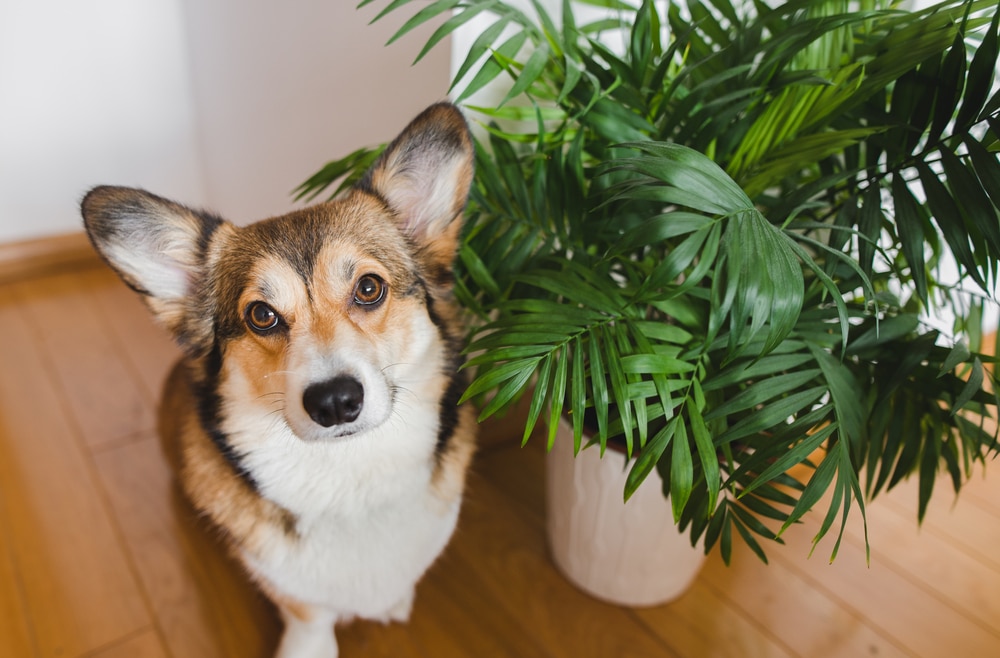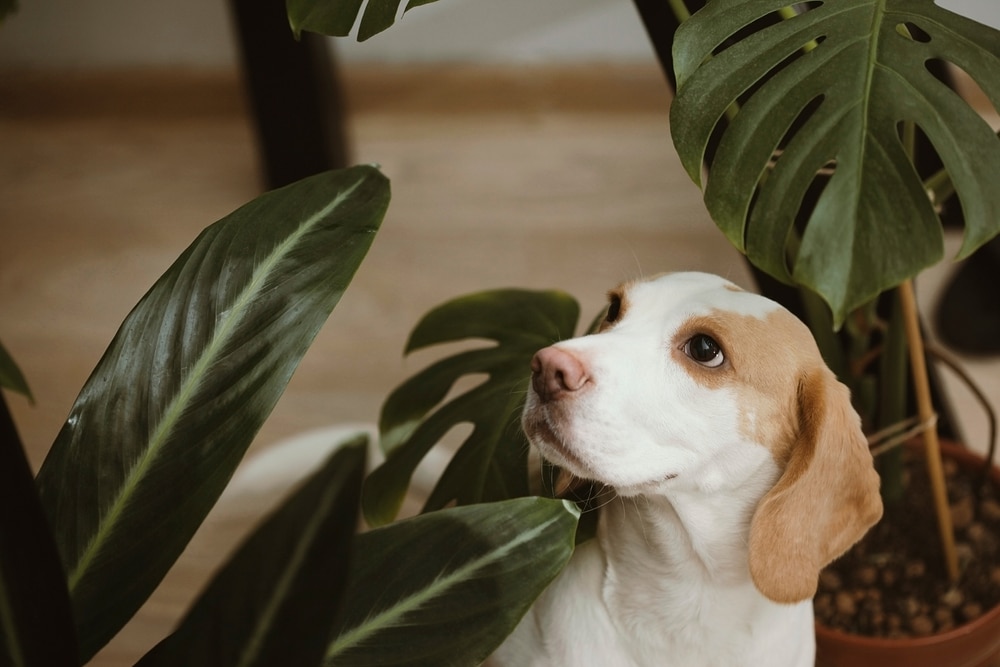Dogs are curious creatures and often have an appetite for all sorts of things, so it’s no surprise that they may show interest in leaves. Leaves are a standard part of our natural world and provide many benefits for humans, but can the same be said for our canine companions? In other words, can dogs eat leaves?
Leaves can be a nutritious and beneficial part of a dog’s diet. Research types of safe, edible plants before feeding your pet to ensure they are non-toxic. Monitor amounts consumed to prevent any digestive issues. Garden plants, wild plants, store-bought fruits, and vegetables can all make for healthy meals for your furry friend. Always consult with your veterinarian before making any changes to your dog’s diet.
Table of Contents
Types Of Safe And Edible Leaves For Dogs

Let’s start with garden plants.
Garden Plants
Leaves of garden plants such as sweet potatoes, zucchini, squash, cucumbers, bell peppers, carrots, and celery are excellent for canine nutrition. This greenery provides a bounty of vitamins A and C, plus dietary fiber for aiding digestion and weight management. Minerals like iron and magnesium also abound in these edible leaves, which can help bolster the immune system.
Edible Greens
Edible greens like spinach, kale, parsley, lettuce, and cabbage offer key nutrients like folic acid, beta-carotene, magnesium, and iron. These can be safely given to dogs in moderation due to their high fiber content. However, it’s important not to go overboard; a little goes a long way!
Hardy Trees And Shrubs
Hardy trees and shrubs are safe for canine consumption, such as dogwood, rosemary, magnolia leaves, and more! These offer valuable minerals such as calcium, vitamins A and C, beta-carotene, and antioxidants. Variety in your pup’s diet is key to a healthy life.
Herb Leaves
Herb leaves such as basil, oregano, and thyme are safe for dogs to consume. These provide vital vitamins, minerals, and antioxidants to benefit your pup’s health. However, certain herbs may be poisonous if ingested in large amounts. Thus, it’s essential to check with a vet before feeding them to your canine companion.
Nutritional Value Of Leaves
Leaves are also rich in minerals like iron, magnesium, and calcium, which help keep bones strong and healthy. These edible greens are high in fiber, which aids digestion, and they are a great source of vitamins A, C, and K, which are essential for overall good health.
In addition, leaves from certain plants, such as dandelions, mulberry, clover, and grape vines, could potentially offer some health benefits for dogs who ingest them.
Health Benefits Of Eating Leaves For Dogs
Here’s what they are:
- Eating leaves can provide essential nutrients such as vitamins and minerals
- Leaves are a great source of fiber, which helps keep your dog’s digestive system healthy
- Certain leaves contain antioxidants that help protect against free radicals and other environmental toxins
- The chlorophyll found in some leafy greens can boost the immune system, helping to fight off infections and illness
- Eating leaves may also reduce inflammation, leading to fewer joint pains or skin irritation issues
Appropriate Leaf Consumption For Dogs
Here’s what to do:
- Only feed leaves that are fresh and pesticide-free
- Make sure to wash the leaves thoroughly before feeding them to your dog
- Feed green leafy vegetables in small quantities first to ensure they don’t have an allergic reaction
- Provide variety by mixing different types of greens so that they can get a balanced diet
- Be cautious when feeding wild plants, as some may be toxic for dogs
- Avoid giving raw spinach and other oxalate-containing vegetables like kale, collards, and Swiss chard
- Steamed or lightly boiled vegetables are more accessible for your dog to digest than raw ones
Potential Hazards Of Eating Leaves For Dogs
Here’s what they are:
- Eating leaves can be hazardous for dogs because some contain chemicals or toxins that can cause vomiting, diarrhea, and other digestive issues in dogs.
- Many plants contain oxalates, which can be toxic to animals and cause symptoms such as drooling, skin irritation, swelling of the mouth or throat, difficulty breathing or swallowing, and even death in extreme cases.
- Plants with trichomes, tiny hairs on the plant surface, can also irritate your dog’s skin.
- Some plants also contain glucosinolates which can cause an upset stomach and gastrointestinal distress in dogs.
- Certain leaves may even contain heavy metals such as lead or mercury that are poisonous to pets if ingested.
- If a leaf has been treated with pesticides or herbicides, it could be dangerous to your pet if they eat it.
- Even dried leaves should be avoided as they may have mold spores that can cause respiratory illnesses when inhaled by your pet.
- Additionally, some leaves contain alkaloids that are harmful to dogs and cats if ingested in large quantities. Alkaloid poisoning may cause vomiting and diarrhea along with seizures and other neurological disorders like tremors and disorientation.
Alternative To Leaves
Store-bought vegetables and fruits are some of the best safe, and most edible plants for dogs to enjoy.
Some of the most popular store-bought vegetables and fruits that can safely be fed to a dog include carrots, apples, bananas, sweet potatoes, celery, pumpkin, blueberries, raspberries, and cucumbers.
Carrots are one of the safest vegetables you can feed your pup as they have numerous benefits, such as helping improve eyesight or providing essential vitamins like A and K while low in calories.
Apples are also a great snack full of vitamins A and C, which provide antioxidants that help boost the immune system while having fewer calories than other fruit snacks.
Bananas have healthy carbohydrates, which can boost energy while offering essential B vitamins and Vitamin C for good canine health.
Celery offers Vitamin K along with folate as well as hydration from its high water content, making it an ideal snack when giving your pup extra liquid intake throughout the day.
Blueberries are full of antioxidants that can help protect against cancer, while raspberries contain ellagic acid, which works to combat urinary tract infections in dogs.
In Conclusion: Can Dogs Eat Leaves?
Leaves can be a healthy part of a dog’s diet and can offer numerous benefits when consumed in moderation. When feeding leaves to your pup, however, caution should be taken as they may contain chemicals or toxins that lead to digestive issues. To ensure safety, make sure any leaf given is fresh and pesticide-free, washed thoroughly, and given in small amounts.
Remember to always consult with a veterinarian if you have any questions about what type of leaves are suitable for your pet’s diet. With these tips, you can ensure that your pup enjoys their greens safely!
So, what leaves are you wanting to feed your dog? Let us know in the comments below how it goes!
